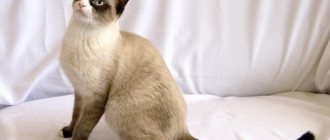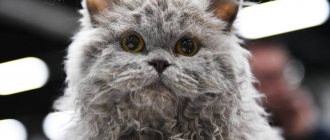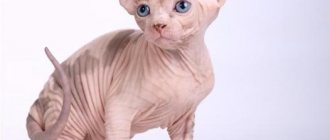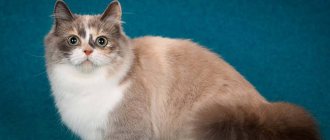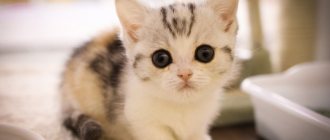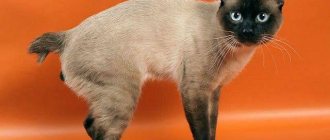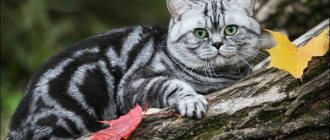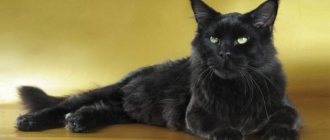Snowshoe (“white foot”, “snow slipper”) is a cat breed with a history of more than 60 years, whose peak of popularity came in 2012 thanks to the Grumpy Cat meme. This is an amazing surprise breed - even breeders cannot predict the location of the kittens' markings.
From a felinological point of view, this breed is for very responsible and scrupulous breeders who are ready for difficulties at exhibitions. And for the family, this is a wonderful companion: sociable, loving attention and affection.
Brief history of the breed
The homeland of cats in snow shoes is the city of Philadelphia in Pennsylvania, USA. It was there that in the 60s of the last century, Siamese breeder Dorothy Hinds-Doherty became interested in unusual kittens with original white markings and pronounced toes.
The woman liked the non-standard color so much that she decided to try to fix it. To achieve her goal, Dorothy bred a Siamese cat with an American Shorthair Bicolor. However, the results of the experiment did not impress the breeder at all. And to improve it, the Siamese cat was re-involved in breeding work.
After felinologists refused to recognize the first snowshoe as an independent breed, Hinds-Doherty stopped breeding them. But her work was continued by another American breeder, Vicki Olander. Her persistence paid off, and the Snowshoe cat breed was eventually standardized.
And in 1974, it was registered by the American Feline Association and the Association of Cat Fanciers as experimental. After 8 years, snowshoes began to be allowed into exhibitions. In 1986, they were included in the British cat breeding program.
Grumpy Cat is the angriest snowshoe
The most famous representative of snowshoe is Grumpy Cat (Russian: Grumpy Cat). It is a cat, not a male cat, as many people think. The cat became popular in 2012 due to its distinctive appearance caused by dwarfism and malocclusion.
The meme with this sad cat became so recognizable that the animal was featured in two advertisements for Friskies food. The book “Grumpy Cat. An angry book from the most angry cat in the world” (Eksmo). The pet brought its owner about 100 million dollars.
The cat died in 2022 from a bladder infection.
Interesting Facts
Interesting facts about this breed will help you get to know the Snowshoe better:
- These cats got their name from their white paws. Translated from English, Snowshoe means “snow shoe.”
- The unpopularity of the breed is explained by the strict requirements of the color standard. Due to the relative youth of the Snowshoe and the presence of recessive genes, breeding these cats is like Russian roulette. No breeder is able to predict what color the kittens from each subsequent litter will have.
Breed description, standards, appearance
Snowshoes are harmoniously built cats with a beautiful color and white paws. They harmoniously combine the gracefulness of the Siamese and the heaviness of the American Shorthair breed.
The generally accepted Snowshoe standard clearly defines the basic requirements for the appearance of cats and the defects of the exterior. According to this document, representatives of the breed who have:
- tail creases;
- not blue iris;
- incorrect body structure;
- strabismus;
- plush wool;
- bulging eyes;
- not white paws.
Dimensions and weight
The Snowshoe is a medium-sized cat with moderate sexual dimorphism. The weight of the female ranges from 4-4.5 kg. The weight of a male can reach 6 kg.
Anatomical characteristics
A typical Snowshoe cat should fit the following description:
- The head is in the shape of an isosceles triangle, with smooth contours, a strong chin and high cheekbones. The nose is moderately wide, with a soft curve at the bridge of the nose and a small hump. The lobe may be pink or spotted.
- The ears are medium wide, tapering smoothly to rounded tips.
- The eyes are oval-shaped, slightly elongated. Directed slightly towards the base of the ears, not protruding. The Snowshoe's iris is colored in any shade of blue or light blue. The brighter the eyes, the more valuable the cat with snow shoes.
- The body is powerful, proportional, with a fairly long neck and well-developed muscles.
- The limbs are of medium length, with oval paws and strong claws.
- The tail is of normal length, gradually tapering to the tip.
Color and coat type
Snowshoes are short-haired cats with smooth, silky, pleasant-to-touch fur.
The following color options are allowed in the breed:
- seal point;
- blue point;
- tortoiseshell.
The main distinguishing features of a purebred Snowshoe are clearly defined snow-white “socks” on all four paws and a spot on the face in the shape of a “V” with the top at the level of the cat’s eyes.
On a note. Snowshoe kittens are born light colored. Their final color is formed only by 2 years.
Mr. Cat warns: features of choice and cost of a kitten
If you decide to choose such an unusual pet as a “snow slipper” as your companion and decide on one of the five colors, or better yet, a nursery, then most likely you will have to wait. There are very few breeders and kittens.
The price of a kitten is very high. Even pet-class pets will not be sold for less than sixty thousand rubles.
Most of the catteries of these amazing cats are located in England. You can order a baby there, but it will be significantly more expensive.
The difficulty in choosing a kitten on your own is that it is impossible for a non-professional to determine whether the baby’s color matches the established standards. Absolutely the entire litter is born white. Even an experienced breeder will not be able to understand what will grow out of each newborn. Only by three to four weeks do the first hints of color appear. But even at this age it is still impossible to predict whether all the necessary “socks” and “triangles” will be in place. Therefore, it is better to purchase a kitten after four months, but remember that the final color will take until two years to develop.
When buying a baby snow, be sure to make sure that you are dealing with this particular breed. Ask to show you the nursery certificate and the pedigrees of the parents. A veterinary passport must be prepared for the pet with marks from the state veterinary clinic on vaccinations against rabies and known infections, and a deworming mark. If you purchase a show or breeding class kitten, be sure to receive a pedigree or birth certificate of the animal.
In Russia, only one professional nursery for these cats is known so far. And if you decide to choose a “snow slipper” of a rare white and pink color (red point), then you should contact English breeders and prepare yourself for a long, possibly more than one year, wait. For breeders, this is a difficult animal to breed precisely because of its exterior features. It is very difficult to mix all the genetic parameters properly and get the perfect male or female. The white color—the mark on the nose and bridge of the nose, the “socks”—is responsible for the non-dominant S gene. If an animal has two of these genes, then there will be more light color. It is difficult to obtain the perfect pattern and color of a Siamese when a mutating factor is included in the genotype.
Photo gallery of Snowshoe cats:
1111
Character and temperament
Snowshoes are cheerful and playful cats with a loving disposition. They quickly become attached to people. For their good attitude, “snow slippers” thank their owners with sincere love and devotion. Cats with white paws subtly sense the change in their master's mood and try to adapt to it.
On a note. Snowshoes need constant communication with people, and if they are left alone, they begin to act out of boredom.
Cats express emotions with their quiet, pleasant voice. Snow-shu easily opens latches and simple locks. They have a real passion for jewelry and shiny things and often hide them.
Snowshoes do not hold grudges and get along well with children. Affectionate and cheerful cats with white paws willingly take part in childish fun and rarely let out their claws. Also, “snow slippers” get along without problems with their brothers and friendly dogs.
How to choose the right kitten
Due to the complexity of breeding and the small number of catteries, searching for a Snowshoe cat can take a long time. Before purchasing a baby, you need to make sure that he has all the necessary documents, which contain information about his ancestors and vaccinations.
When choosing a Snowshoe kitten, it is important to pay attention to its compliance with the standards. An important role in choosing a pet is played by signs that indirectly indicate its well-being. A healthy kitten has a soft belly, smooth skin without scratching, fluffy fur without bald spots and clear eyes.
Kitten care
It is advisable to pick up a small Snowshoe from a breeder no earlier than he is 3 months old. By this time, the kitten already has all the vaccinations and is prepared for independent life. Since a snowshu from a good nursery arrives at a new home accustomed to basic skills, the owners only have to show him where the food and water bowls, tray, scratching post and place to sleep are located.
To prevent a kitten with white paws from harming itself, medicines, wires, detergents, small objects and ornamental plants are hidden from it in advance. Also, for safety reasons, the little snow-shoe is limited in access to large household appliances, and special nets are placed on the windows.
Breeding
The process of breeding the Snowshoe breed has a number of features. Mating is carried out in a standard manner, but obtaining offspring that meets the standard is associated with some difficulties. Snowshoes rarely have the perfect pattern, so breeders have to cull up to 50% of the kittens in each litter.
Sexual maturity in females occurs at 7-9 months. The first mating is carried out after the third heat. The female is brought into the male's territory. It is best to look for the manufacturer in licensed nurseries, or even better, where the cat was taken from.
Basic requirements for a partner:
- documents confirming the purity of the breed;
- health certificates and vaccination passport;
- knitting experience.
The recommended frequency of births is 2 times every three years. Frequent childbirth depletes the female’s body, which subsequently negatively affects her health and the well-being of the babies.
Care and maintenance
Snowshoes are clean animals, and they also love water. Cats with white paws do not require special conditions and do not cause unnecessary trouble.
Hygiene procedures
Caring for a Snowshoe comes down to standard procedures applicable to cats of any other breed:
- The snowshu's eyes are wiped daily with a piece of natural fabric moistened with boiled water or herbal infusion.
- The ears of the “snow shoe” are cleaned once a week to remove accumulated dirt. A special product is instilled into each of them and after a few minutes they are wiped with cotton pads.
- The cat's teeth are brushed twice a week with a soft silicone brush and a small amount of non-foaming toothpaste. This simple procedure will protect your snowshoe from dental problems.
- The claws of the “snow shoe” are shortened as necessary with a nail clipper, and only the transparent tips are removed.
Grooming
To maintain the beauty of a cat's coat, brush it regularly with a special brush. In normal times, the procedure is carried out 2-3 times a week. During the molting period, Snowshoes are brushed more often.
Bathe your cat in snow shoes once a quarter. To do this, use warm water and a special shampoo for short-haired breeds. After bathing procedures, the snowshu's wool is thoroughly dried with a terry towel and, if necessary, dried with a hairdryer.
Tray
For snow-shu, select a spacious tray with high sides. It is filled with the filler recommended by the breeder or the one the cat likes.
On a note. At first, you can pour a special fine-grained litter for kittens into the “snow slipper” tray - it does not stick to the animal’s paws. As the snowshu gets older, it is replaced with one that has larger granules.
Walk
The pet can be trained to walk with its owner, and the furry beauty does not mind a special cat collar.
On the street he behaves inquisitively, sniffs everything, quickly gets used to it and stops being afraid.
To avoid tick a protective collar on your pet .
Since the animal is a contact animal, you should never let it off the leash.
And one more condition: do not let your pet go for a walk with children. You can easily lose a rare pussy.
Curious cats
A more convenient option is to release the cat into the wild if you have a summer house.
The animal will actively explore the world without being afraid of it at all.
But keep an eye on him: he can easily run away.
Feeding the cat
To keep your Snowshoe looking good and feeling healthy, she needs a balanced diet. You can feed a cat wearing snow shoes both dry and natural food. The main thing is that the food is fresh and of high quality.
Complete diet
When feeding dried snow slippers, they buy premium or super-premium products that do not contain questionable additives. It already contains all the necessary vitamins and maintains a balance of valuable substances.
The following foods are best suited for cats of this breed:
- Royal Canin;
- Pronature;
- Pro Plan;
- Bosch;
- Gemon.
With a natural type of nutrition, lean fresh meat should predominate in the snowshoe's diet. Also, a cat of this breed is given:
- boiled vegetables;
- offal;
- boiled eggs;
- porridge with water;
- sour milk;
- ocean fish.
Like cats of any other breed, starchy vegetables, sweets, smoked meats, sausages, beans and any leftovers from the master's table are contraindicated for Snowshoes. You cannot feed the “snow slipper” pork, bones, river fish and whole milk.
Feeding frequency
Due to age characteristics, a Snowshoe kitten needs to be fed more often than an adult representative of the breed:
- up to 12 weeks – 5-6 times a day;
- 3-5 months – 4 times a day;
- 5-12 months – 3 times a day.
A one-year-old “snow slipper” is fed twice a day.
Vitamins and minerals
When feeding natural products, an imbalance of microelements may occur in the Snowshoe's body. To compensate for their deficiency, the cat in snow shoes is given mineral supplements twice a year, which are selected with the participation of a veterinarian.
Education and physical activity
Snowshoes are temperamental, active and jumping cats, prone to mischief. Representatives of the breed love active games and need space to splash out energy. To prevent the “snow shoes” from getting bored, they buy several different toys and equip them with a sports corner.
On a note. Cats of this breed have a real passion for water. “Snow Shoes” love to swim and just watch the flowing stream.
Snowshoes are highly intelligent cats and are easy to train. “Snow Shoes” not only easily learn the rules of behavior in the house, but are also able to perform simple tricks such as offering abandoned toys.
Vaccinations and antiparasitic treatment
To protect the Snowshoe from infectious and viral diseases, the cat is routinely vaccinated against calcivirosis, panleukopenia and rhinotracheitis. The first vaccination for a kitten of this breed is given at the age of 7-8 weeks. After 28 days he is vaccinated against the same diseases and against rabies. In the future, the cat is vaccinated annually.
To prevent diseases transmitted by exo- and endoparasites, Snowshoes are systematically treated for fleas and worms. Anthelmintic drugs are given to cats of this breed strictly by weight once every six months with mandatory repetition after 10-14 days.
Snowshoes are treated against fleas with special shampoos or drops. And if a cat wearing snow shoes has access to the yard, an anti-parasitic collar is put on it.
Pros and cons of the breed
Cats in snow shoes have not only advantages, but also disadvantages:
| pros | Minuses |
| Attractive exterior | Difficulties in breeding |
| High intelligence | Tendency to steal and other mischief |
| Good health | Intolerance of loneliness |
Snowshoe is a beautiful short-haired cat with extraordinary colors and an almost perfect character. She will be an excellent companion for those who dream of a mischievous pet and are ready to put up with his craving for jewelry and shiny trinkets.
Health
The Snowshoe cat looks healthy and cheerful - it’s all about proper care of the pet
The good thing about this breed is that it has virtually no concomitant diseases.
It is believed that with proper care, white-legged animals live fully into old age, practically without being exposed to any diseases.
If you are interested in looking at the scariest cat in the world, we recommend that you read the article
Still, you should take your pet to the veterinarian to immediately identify possible or existing problems.
In general, we can say that these are healthy, strong, active animals.
